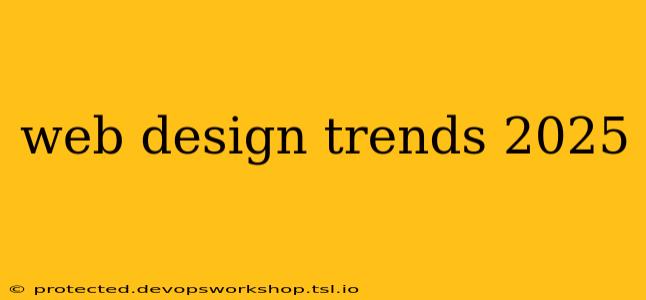The digital landscape is in constant flux, and web design is no exception. 2025 promises a fascinating evolution, driven by technological advancements and evolving user expectations. This isn't just about aesthetics; it's about creating seamless, intuitive, and accessible online experiences. Let's delve into the key web design trends predicted to dominate in 2025.
AI-Powered Personalization: Beyond the Basics
Artificial intelligence is no longer a futuristic concept; it's actively shaping the present. In 2025, AI's role in web design will extend beyond simple recommendations. Expect to see:
- Hyper-personalized content: AI will analyze user behavior, preferences, and even emotional cues to deliver truly tailored content, layouts, and even interactive elements. This goes beyond simple product suggestions; it involves dynamically adjusting the entire user journey.
- AI-driven design tools: The design process itself will be augmented by AI, offering intelligent suggestions for layout, color palettes, and even code generation. This will empower both professional designers and novice users to create stunning websites with greater efficiency.
- Predictive design: AI can anticipate user needs and proactively offer solutions. Imagine a website that anticipates your next action based on your past behavior, streamlining your experience.
Immersive Experiences: Stepping into the Metaverse (and Beyond)
The metaverse is gaining traction, and its influence on web design is undeniable. Expect to see:
- 3D and AR/VR integration: Websites will become more three-dimensional, incorporating interactive 3D models, augmented reality experiences that overlay digital content onto the real world, and virtual reality environments that transport users into completely immersive digital spaces.
- Spatial web design: Designers will need to think beyond the traditional two-dimensional screen. Understanding spatial relationships and creating intuitive navigation within three-dimensional spaces will be paramount.
- Enhanced user interaction: Expect to see more haptic feedback, voice interaction, and gesture-based controls, making interactions more natural and intuitive within these immersive environments.
Sustainable Design: Prioritizing Ecology and Accessibility
Ethical considerations are becoming increasingly important in all aspects of life, including web design. In 2025, we'll see:
- Eco-friendly web hosting: The environmental impact of websites is a growing concern. Expect a greater focus on carbon-neutral hosting providers and efficient website design that minimizes energy consumption.
- Accessible design: Inclusive design will become even more critical. Websites will be meticulously crafted to be accessible to users with disabilities, employing best practices for screen readers, keyboard navigation, and color contrast.
- Responsible resource usage: Designers will prioritize lightweight code, optimized images, and efficient loading times to minimize the environmental impact and ensure a smooth user experience for everyone.
Micro-interactions and Motion Design: Enhancing User Engagement
Subtle animations and interactive elements play a crucial role in creating engaging user experiences. In 2025, we can anticipate:
- Refined micro-interactions: Small, delightful animations that provide feedback and enhance user engagement will be even more sophisticated and seamlessly integrated into the overall design.
- Strategic motion design: Animations will be used to guide users, highlight important information, and create a more dynamic and engaging experience.
- Emphasis on user experience: The focus will always remain on the user's needs. Motion and micro-interactions will serve a clear purpose, not just for aesthetic appeal.
The Continued Rise of Minimalism: Clean, Simple, and Effective
While immersive experiences will gain prominence, minimalism will remain a significant force in web design. Expect to see:
- Clean layouts and typography: Clear, uncluttered designs that prioritize readability and ease of navigation will continue to be popular.
- Emphasis on whitespace: Strategic use of whitespace will create visual hierarchy and improve readability.
- Focus on essential content: Only crucial information will be presented, eliminating distractions and improving the overall user experience.
Conclusion: A Future of Seamless and Personalized Experiences
Web design in 2025 will be driven by a convergence of technology, ethics, and user-centricity. The trends outlined above represent a glimpse into a future where websites are not simply static pages but dynamic, personalized, and immersive experiences tailored to individual users. By embracing these trends, designers can create websites that are both visually stunning and deeply engaging. The key takeaway? The user experience will remain the ultimate measure of success.

